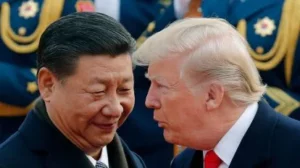UPSC Relevance
- GS-2: International Relations – India-China Relations, China-U.S. Strategic Competition
- GS-3: Economy – Global Trade Conflicts, World Trade Organization (WTO), Tariff Disputes

Key Points
Intensifying Trade Conflict
- In retaliation to the Trump administration’s increase of tariffs on Chinese goods to 145%, China has imposed a 125% tariff on U.S. products.
- Between April 2 and April 11, both nations engaged in a cycle of retaliatory tariff hikes, signaling a worsening economic confrontation.
Timeline of Tariff Escalations
- April 2: The U.S. added a 34% tariff, bringing the total to 54%.
- April 4: China responded with an equivalent 34% tariff.
- April 7: The U.S. escalated tariffs to 104%, a 50% increase.
- April 9: China raised its tariffs to 84%.
- April 11: China finalized its response with a 125% tariff.
Diplomatic Ramifications
- China’s Customs Tariff Commission described the tariffs as “a mockery of global economic history.”
- While Beijing expressed willingness for negotiations, it cautioned that it would take firm actions if the U.S. continues to threaten its economic interests.
Economic and Geopolitical Implications
- The U.S.-China tariff dispute threatens to disrupt global trade networks, particularly affecting developing economies.
- For India, this could lead to supply chain challenges, opportunities for trade redirection, and fluctuations in currency stability.
Analysis and Path Forward
- The escalating trade war underscores the vulnerability of global trade bodies like the WTO.
- India should focus on diversifying trade partners bilaterally, strengthening regional trade alliances, and maintaining economic policy independence to navigate these challenges.




